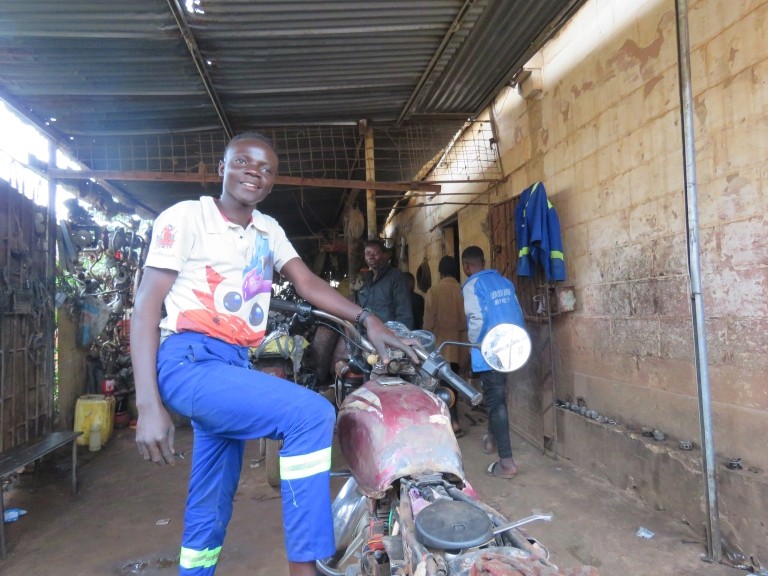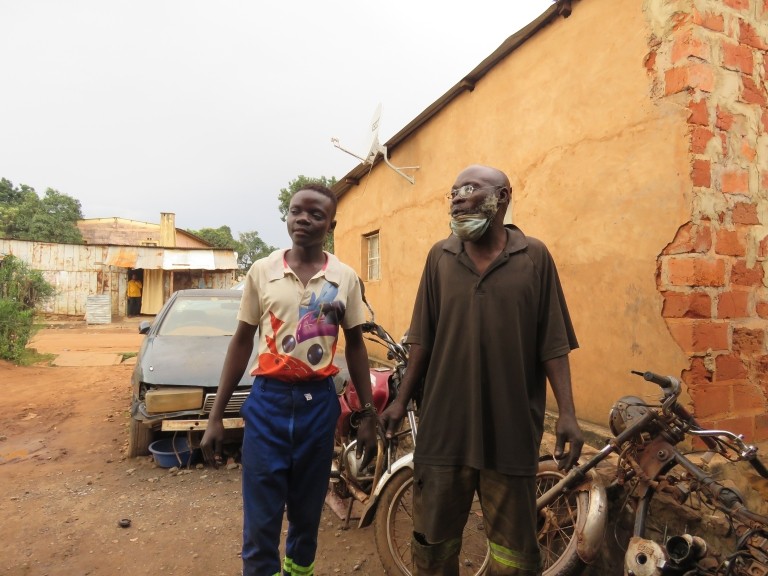Blog
Through apprenticeships, DRC youth develop new trades and leave the dangers of mining behind

“I worked in the quarry with two of my friends for two years,” said Nkongolo Kasonga Patrick, a 17-year-old living in the Democratic Republic of Congo. “I started working there because both my parents were unemployed and couldn’t afford to send us to school or pay for clothing or shoes. There was very little food at home, and we only ate one meal a day in the evening.”
One of eight children, Patrick recently lost his father in 2020. Today, his mother sells spices and vegetables, including tomatoes, onions and celery, at the Kapata market in Kolwezi.
For many young people like Patrick, working at a mine is a sure way to earn money in the mineral-rich country, particularly as the world’s green revolution continues to fuel demand for cobalt. But it is also dangerous to their health and development, not to mention illegal. Considered one of the worst forms of child labor by the International Labor Organization, child labor in mining exposes kids to dangerous conditions, physical injury, mental stress, disease and disenfranchisement. In DRC, Pact is helping youth to leave the mines by raising awareness of the dangers, strengthening families’ economic stability, improving enforcement of child labor bans, and teaching youth new trades through apprenticeships.
Neighborhood committees – volunteer groups made up of community members – increase awareness of the dangers of child labor in their communities and provide options for children and their families, options like the apprenticeship program.
“When working at the quarry, a member of the Kapata neighborhood committee explained the dangers of child labor in mining, as well as my rights, as a child,” said Patrick. “I was then selected to partake in the apprenticeship program, which started in April 2021. I chose to learn welding and today, I believe that I am a good welder.”
Youth are paired with a mentor who helps them to learn their trade, developing critical skills and experience for life.

“My life has changed so much! I am now able to buy clothes, I do not worry about food anymore, and I can also support my family and pay for three of my siblings’ school fees. I am also able to save some money regularly.”
For many youth, they also become advocates for stopping child labor, helping to spread the word among other youth in their communities.
“I am involved in the fight against child labor in my neighborhood. I raise other children’s awareness on the dangers of working at mining sites, and tell them about the frequent illnesses, the landslides, the physical violence and many other things,” said Patrick. “I do this with children I meet individually, but also when I play soccer with other children. I have worked in the mines, so I know how it is there; I am well aware of the challenges children face there,” he continued.
This year, Patrick spoke with five children who were afraid of being identified as child miners by Pact during the annual campaign to identify adolescent miners for enrollment in the apprenticeship program. He shared his experience with the apprenticeship program and the transformation the program has brought to his life. Because of Patrick’s advocacy with those youth, today, all five children are apprentices in the program.
According to Patrick, the number of children working at the mines usually increases during the holidays. “Even those children who don't go regularly [to work in the mines] want to make some money to purchase school supplies and their school uniforms." Also, at the peak of the Covid-19 epidemic in 2020, when schools were closed for six months due to the state of health emergency, many children went to work at the mines because they had nothing else to do in the community.
Thanks to the neighborhood committee’s work, Patrick believes that many people now understand that children are not allowed to do heavy work until they are 18 years old. They understand the dangers that child labor in mining presents to kids.
“I believe that in the past couple of years, the number of children working at mining sites in Kapata has decreased because many children have returned to school full time, thanks to their parents being integrated into WORTH groups [Pact’s savings and loan program]. Also, several former adolescent miners have enrolled in Pact’s apprenticeship program and have left the mines for good.”
While there is much to celebrate, for Patrick – and for Pact – the work continues.
“I believe that Pact’s work is important to end child labor, but we would need more resources to enable more vulnerable households to develop economic activities and to increase the number of children enrolled in the apprenticeship program. In addition, the Congolese government needs to properly regulate artisanal mining and take enforcement action against parents who continue to send children to work. Having said that, I will continue to make my contribution to the collective effort and advise child miners when I have the opportunity to do so.”
“I feel very proud to have left the mines and to have a noble trade, which allows me to take care of myself and my family. I feel even prouder when I talk to children, and they listen to me!”
Patrick was interviewed by Pact staff in DRC in his former mentor’s workshop, where he now works as an assistant.